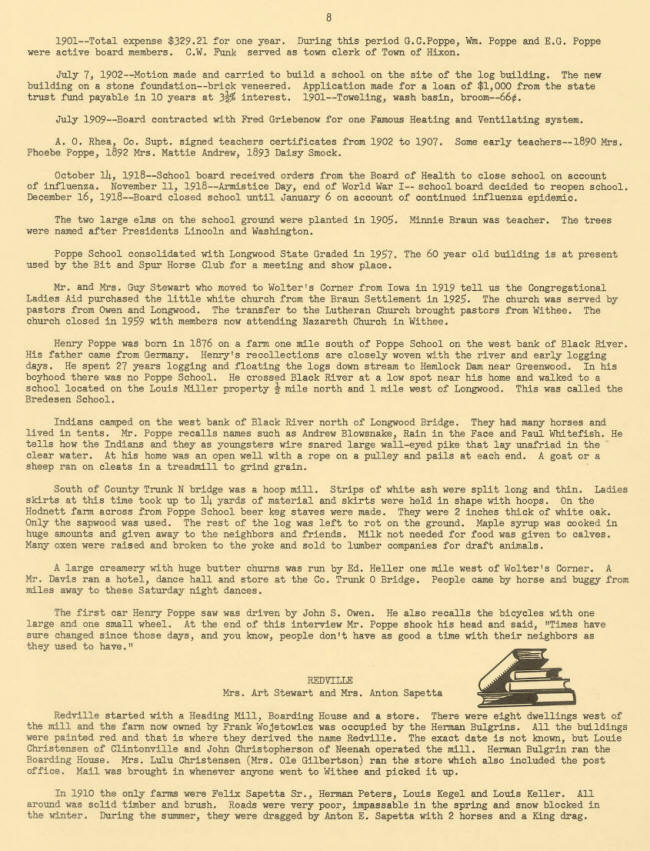|
[Memory
Trails Index]
Transcription
Janet Schwarze
1901—-Total expense
$329.21 for one year. During this period G. C.Poppe, Win. Poppe and E.G. Poppe
were active board members. C.W. Funk served as town clerk of Town of Hixon.
July 7, 1902--Motion made and carried to build a school on the site of the log
building. The new building on a stone foundation—-brick veneered. Application
made for a loan of $1,000 from the state trust fund payable in 10 years at 3
interest. 1901--Toweling, wash basin, broom--66.
July 1909—-Board contracted with Fred Griebenow for one Famous Heating and
Ventilating system.
A. O. Rhea, Co. Supt. signed teachers certificates from 1902 to 1907. Some early
teachers—-1890 Mrs. Phoebe Poppe, 1892 Mrs. Mattie Andrew, 1893 Daisy Smock.
October 14, 1918——School board received orders from the Board of Health to close
school on account of influenza. November 11, 1918--Armistice Day, end of World
War I-- school board decided to reopen school. December 16, 1918——Board closed
school until January 6 on account of continued influenza epidemic.
The two large elms on the school ground were planted in 1905. Minnie Braun was
teacher. The trees were named after Presidents Lincoln and Washington.
Poppe School consolidated with Longwood State Graded in 1957. The 60 year old
building is at present used by the Bit and Spur Horse Club for a meeting and
show place.
Mr. and Mrs. Guy Stewart who moved to Wolters Corner from Iowa in 1919 tell us
the Congregational Ladies Aid purchased the little white church from the Braun
Settlement in 1925. The church was served by pastors from Owen and Longwood. The
transfer to the Lutheran Church brought pastors from Withee. The church closed
in 1959 with members now attending Nazareth Church in Withee.
Henry Poppe was born in 1876 on a farm one mile south of Poppe School on the
west bank of Black River. His father came from Germany. Henry’s recollections
are closely woven with the river and early logging days. He spent 27 years
logging and floating the logs down stream to Hemlock Dam near Greenwood. In his
boyhood there was no Poppe School. He crossed Black River at a low spot near his
home and walked to a school located on the Louis Miller property mile north and
1 mile west of Longwood. This was called the Bredesen School.
Indians camped on the west bank of Black River north of Longwood Bridge. They
had many horses and lived in tents. Mr. Poppe recalls names such as Andrew
Blowsnake, Rain in the Face and Paul Whitefish. He tells how the Indians and
they as youngsters wire snared large wall-eyed pike that lay unafriad in the
clear water. At his home was an open well with a rope on a pulley and pails at
each end. A goat or a sheep ran on cleats in a treadmill to grind grain.
South of County Trunk N bridge was a hoop mill. Strips of white ash were split
long and thin. Ladies skirts at this tine took up to 1k yards of material and
skirts were held in shape with hoops. On the Hodnett farm across from Poppe
School beer keg staves were made. They were 2 inches thick of white oak. Only
the sapwood was used. The rest of the log was left to rot on the ground. Maple
syrup was cooked in huge amounts and given away to the neighbors and friends.
Milk not needed for food was given to calves. Many oxen were raised and broken
to the yoke and sold to lumber companies for draft animals.
A large creamery with huge butter churns was run by Ed. Heller one mile west of
Wolter’s Corner. A Mr. Davis ran a hotel, dance hall and store at the Co. Trunk
0 Bridge. People came by horse and buggy from miles away to these Saturday night
dances.
The first car Henry Poppe saw was driven by- John S. Owen. He also recalls the
bicycles with one large and one small wheel. At the end of this interview Mr.
Poppe shook his head and said, “Tines have sure changed since those days, and
you know, people don’t have as good a tine with their neighbors as they used to
have.”
REDVILLE
Mrs. Art Stewart and Mrs. Anton Sapetta
Redville started with a Heading Mill, Boarding House and a store. There were
eight dwellings west of the mill and the farm now owned by Frank Wojetowicz was
occupied by the Herman Buigrins. All the buildings were painted red and that is
where they derived the name Redville. The exact date is not known, but Louie
Christensen of Clintonville and John Christopherson of Neenah operated the mill.
Herman Buigrin ran the Boarding House. Mrs. Lulu Christensen (Mrs. Ole
Gilbertson) ran the store which also included the post office. Mail was brought
in whenever anyone went to Withee and picked it up.
In 1910 the only farms were Felix Sapetta Sr., Herman Peters, Louis Kegel and
Louis Keller. All around was solid timber and brush. Roads were very poor,
impassable in the spring and snow blocked in the winter. During the summer, they
were dragged by- Anton E. Sapetta with 2 horses and a King drag.
[Next]
[Memory
Trails Index]
|
